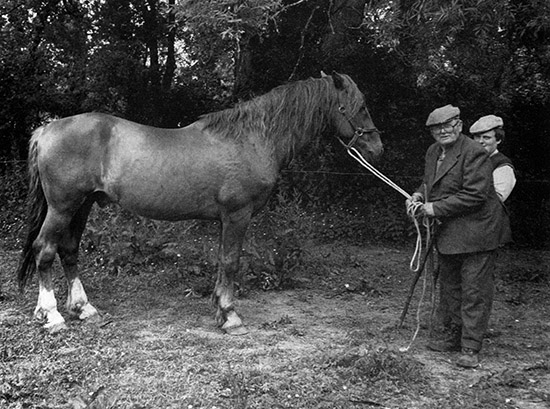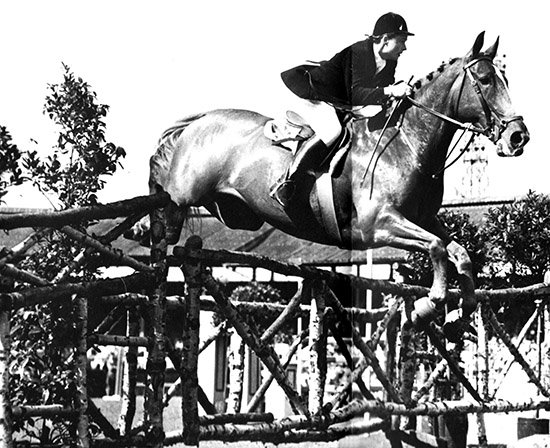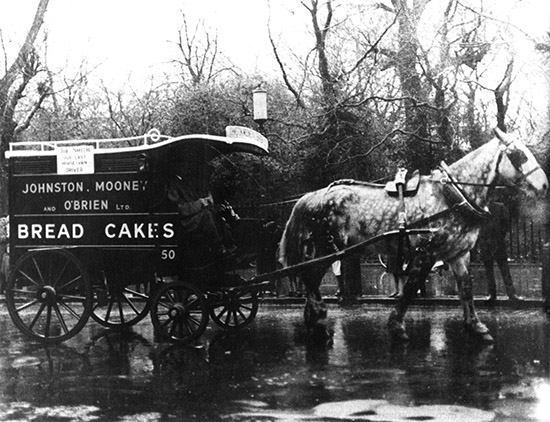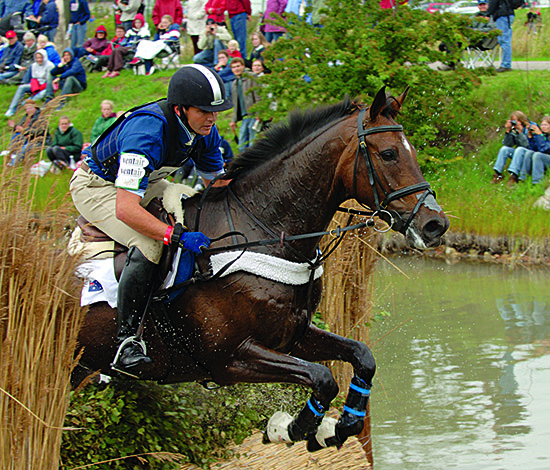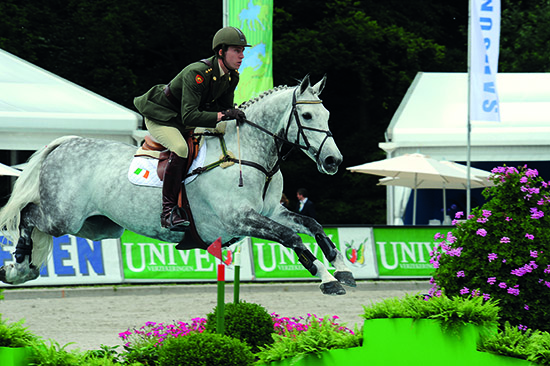Is the Irish Draught a Warmblood? The breed is excluded from The International Warmblood Horse by Celia Clarke and Debbie Wallin, with the Consultant Editor Jane Kidd explaining the omission in her introduction on the grounds ‘that the distinguishing feature of Warmbloods is that they are specifically bred by selective methods to produce an athletic, sound horse with a good temperament; the breeding stock used is registered, has pedigrees and is graded to ensure that it is likely to improve the quality of the next generation of Warmbloods.’
And yet for all the failure of the Irish to develop the tightly organized administrative structure of the European studbooks, there are huge historical similarities – and now, with top European sires standing in Ireland perhaps it is time to welcome the Irish into the fraternity of the Warmblood. At the 2007 Autumn Irish sales, Holland’s famed Nijhof stud purchased a colt by Guidam out of a King of Diamonds mare. A Warmblood? The reaction of the KWPN will be interesting.
Certainly the mare base, as described by Alex Fell in The Irish Draught Horse, sounds remarkably similar to the native mare populations in Germany and Holland: “a multi-purpose, active farm horse, capable of tilling a small farm, pulling a sidecar to market and milk to the creamery at a steady trot, carrying the farmer out hunting, and breeding a foal each year to sell (usually by a Thoroughbred horse, and often to foreign buyers). It had to be dependably sound throughout its working life, because the livelihood of the small farm depended on the reliability and efficiency of this horse.”
And, as in continental Europe, the Irish horse would seem to have descended from a familiar mix of Spanish, Anglo-Norman and Thoroughbred stock.
Matthew Kenny, in evidence to the Royal Commission on Horse Breeding in Ireland in 1897, referred to the ‘Old Irish Mare’ as ‘small, clean legged and hardy.’ “This breed,” he stated, “originated i the numerous Spanish stallions brought to Ireland in the sixteenth century. There was regular trade between the south and west of Ireland and Spain for many centuries, Ireland exporting wool, hides and butter and received in return wine, cloth horses and specie. The class of Spanish horse introduced was the Andalusian
Barb.” (The Irish Draught Horse by Alex Fell, page 23)
Again, like the European horse, the demands of the military drove the development of the Irish horse. To quote Alex Fell again: “Thus the roots of the Irish Draught are not so much agricultural as military. Dr Cox, in his evidence to the Royal Commission in 1897, mentions the export of the ancient Irish horse for military purposes, and this has been an unbroken tradition up to the present day.”
In the latter nineteenth century, in a deliberate attempt to improve the breed, a scheme was put into place where Thoroughbred stallions competed for a premium on the understanding that they were to serve not less that 50 half-bred (ie. non-Thoroughbred) mares. One of the early stallions in the scheme, Vanderhum was the sire of the dam of Comet, the first officially registered Irish Draught stallion. Irish Draught stallions were first registered with the Department of Agriculture in 1907 and in 1918, Volume 1 of The Irish Draught Horse Book was published.
In 1966, the then Minister of Agriculture (later Prime Minister) Charles Haughey commissioned a report on the Horse Breeding Industry. Haughey was himself a prominent horse breeder and one time owner of the puissance specialist, Abbeville, who competed as Miss Moet with Nelson Pessoa. As a result of the report, the Irish Horse Board came into being in 1976, the same year the Irish Draught Horse Society was formed.
The jumping ability of the Irish horse had been noted at an earlier government investigation. The 1897 Royal Commission on horse breeding in Ireland, was told of Shauntree who had set a record by jumping 6 foot 11/2in at Dublin Show. The cross of Thoroughbred stallion on Irish mares resulted in a lucrative trade in hunters to neighbouring England.
In the early part of the twentieth century, the Irish half-bred was a showjumping star. Limerick Lace, who took off the Prize of Berlin in 1934, was one of the first international showjumping stars of the Irish military team. Flanagan took Pat Smythe to the 1956 Olympics, and again to Rome in 1960; the D’Inzeo brothers rode Bellevue, Easter Light and The Rock; David Broome starred on Mr Ross, Mr Softee and Queensway Sportsman; Towerlands Anglezarke and Malcolm Pyrah; Heather Honey and Paul Darragh; Eddie Macken and Carroll’s Royal Lion and Boomerang; Warren Point and Ryan’s Son with John Whitaker and Next Commander Henry with brother, Michael, all contributed to the international fame of the Irish jumper.
Pat Smythe and the Irish bred Flanagan – in 1955 he was three classes in Paris, two at the White City and the Ladies Championship. The following year he won the Grand Prix at Lucerne before going on to compete in the 1956 Olympics. Pat Smythe rode Flanagan at the 1960 Olympic Games, finishing in 11th place
An analysis by the journalist, Michael Slavin, established that for the years 1975-1977, out of 140 Grand Prix conducted worldwide, 20 were won by Irish bred horses.
So strong was the Irish horse in the jumping arena that you are tempted to ask, what went wrong? Where did they go? Since of recent years, pickings have been slim on the international scene.
Perhaps the answer is to be found in that phenomenon that afflicts all breeds of horse – the breed society true believer. They are the ones who if they breed Andalusians instead of concentrating on breeding out the winging front legs in trot – celebrate it as a breed characteristic… Perhaps something like this happened in Ireland where breeding remained static and insular, in precisely that period where new blood was flowing from one side of Europe to the other, lifting jumping abilities of the modern Warmblood to a level where the Irish horse (with numerous notable exceptions) could not compete. Recent moves to welcome the best of European breeding into the Irish breeding scene may hold out hope of a revival of the Irish Horse as a force on the international stage.
Opening up the Irish Book
The unwillingness in the past to accept ‘foreign’ blood, perhaps explains why the Irish horse has largely disappeared as a force from the international scene. While there are still some excellent three day eventers of Irish Thoroughbred or largely Thoroughbred breeding, the Irish Draught as an international showjumping competitor seems to have fallen victim to the curse of the closed studbook. While the rest of Europe was renovating their genetic stocks, and the trade from one book to another swelled with every passing day, the Irish authorities stuck their collective head in the sand.
The most successful ‘Irish’ sire at the 2006 WEG was the Holsteiner registered Cavalier Royale (by Cor de la Bryère out of a Liguster mare), the sire of the showjumper, Chippison and the eventers, Clayton Fredericks’ Ben Along Time and Mary King’s Call Again Cavalier. Cavalier Royale starred again at the Beijing Games with the WEG eventing twosome joined by another, Kilkishen (in the Irish team) and the Swedish showjumper, Calibra II. Cavalier Royale was only admitted to the Irish stud book late in his life on the basis of the success of his progeny in sport.
Ben Along Time and Clayton Fredericks in action…
As in the rest of the world, we see that the process of modernization is also a process of globalization.
The first of the imported stallions to make a mark in Ireland was Furisto, a son of Furioso II out of a Dominus mare. His first Irish born progeny to appear in the sport, were born in 1989. In his lifetime he produced 276 foals for the Irish Horse Registry.
The aforementioned Cavalier Royale’s first progeny were born in 1991 and in his lifetime he produced 1,031 foals for the IHR, and, thanks to frozen semen, there are still a few being born today.
The Dutch stallion, Hallo (Animo / Wellington) first produced Irish foals in 1993, with 157 registered as at 2007. Horace, an Anglo Arab by Long Courier out of a Pancho II mare produced 197 foals, with his first Irish crop in 1987.
In 1978, there were no foreign bred Sport horses registered with the Irish Horse Board. In 1990, there were four, and by 2004, there were 39 foreign bred stallions who were standing in Ireland with another 51 approved for use, but not resident in Ireland. In 1981, there were 0% of foals by foreign bred sires, by 2003, the figure was 26.1%. The Approved Stallions 1987 booklet lists two foreign stallions, in the 2004-5 Approved Stallion book, there are 18 different foreign breeds listed.
The best of both worlds? River Foyle – by the Holsteiner, Cavalier Royale out of a mare by Cruising, with Shane Carey…
Obliviously, in Ireland too, ‘the times they are a changing’.
In an insightful report of the 2007 Autumn Sport Horse sales, by Sally Parkyn in the December 2007, Breeding News, her analysis of the top prices reveals how far the Irish have come from the days where the standard Irish dealers reply to a question of parentage, was ‘and what would you like him to be by?’ Seemingly the buyers with the big money wanted to see the name of either Cavalier Royale or Cruising on the paper. The top priced filly at the sale (€20,000) boasted both – being by Cavalier Royale and out of a Cruising mare who in turn was out of a mare by Clover Hill. But on the other side, there was Tom Meagher, whose Kedrah House stud stands Ricardo Z (Rebel / Furioso II) and Lux Z (Lord Calando / Ahorn Z) buying a very traditionally bred colt, by Cruising out of Clover Hill mare.
Parkyn quotes Meagher as saying: “Now is the time to introduce traditional breeding back into pedigrees and I was on the look-out for a native stallion to cover our European bred mares.”
And just to round off this picture of trans-European cross fertilization, two foals at the Autumn auction, were bought by the Dutch Nijhof Stud – a filly by Guidam out of an unnamed Clover Hill mare who is the full sister to Harvey Smith’s former Puissance specialist, Brookstreet Clover, and a Guidam colt out of an unnamed Cruising mare.
And in a reverse of that move, the Irish door opened just that bit further in May 2008, when the Irish Horse Board approved the 5-year-old stallion Wang Chung M2S (Royal Bravour x Ahorn x Erdball xx). He was bred by Morningside Stud and is the first Irish-bred KWPN-registered stallion approved by the IHB.
The IHB’s inspection team traveled to Holland to inspect the horse, led by Ned Campion, who was a member of the Irish showjumping team at the Mexico City Olympics. The inspection team included veterinary surgeon Tom Hurley and Irish international rider Enda Carroll as test rider.
Earlier in the year, Wang Chung M2S won the Future Stallion Championship at the CSI** Zwolle International Show. In this two day competition for 25 approved stallions from across Europe, Wang Chung placed 4th on the first day and won the class on the second day. His overall ranking earned him the title of Future Stallion Champion – the first time this honour has been won by an Irish-bred horse.
And yes, just as we have found in all the breeding areas we have surveyed, there is concern over the changing face of breeding. After noting that ‘there is a widening gulf between the top and bottom end of the market, with the traditional farmer losing out to the commercial producers.’ Sally Parkyn concludes: “Although Ireland has an enviable reputation of producing world-class sport horses, it has largely relied on its wealth of ‘farmer breeders’ to produce the goods, and indeed, although totally unscientific, due to the wonderful characteristics of the Irish half bred mare, and the Irishman’s affinity with the horse, it has largely been successful. However, the growing influence of the European-bred stallions is making itself known, and whilst the outcome is proving commercial in the sale ring, time alone will confirm whether these sires will help Irish breeding to achieve on the world stage.”
The ‘Warmblood Invasion’ of Ireland was given official recognition by the Minister of Agriculture, Fisheries and Food, Brendan Smith when in March 2009, he approved the Warmblood Studbook of Ireland’s application to operate, under EU and Irish legislation, the studbook for the Irish Warmblood horse. This historic action has ended the monopoly on sport horse breeding in Ireland previously exercised by the Irish Horse Board/Horse Sport Ireland.
The Warmblood Studbook of Ireland (WSI), a division of Irish Warmblood Studbook Ltd, was founded by Tom Reed and Dawn Kelly, owners of Morningside Stud, and Claire Wood, a horse breeder and trainer also from the Killaloe/Ogonnelloe area of County Clare.
WSI’s mission is to help breeders produce international showjumpers. The Studbook will conduct stallion and mare inspections and the focus is on breeding stock that has clear potential to produce international showjumpers. Each foal will be inspected and the results of those inspections will be fed back into the Studbook’s ongoing stallion and mare evaluations. Strict limits have been put in place to restrict the percentage of Irish Draught blood in the stallions and mares approved by the WSI.
“We shall measure our success by how many foals we produce that later become international showjumpers, not by how many foals we register,” said Dr. Thomas Reed, Managing Director and Breeding Director of the WSI.
“By design we are committed to staying small and selective and to working with like-minded breeders with very good mares who are committed to our vision, goals and strategy for the Irish Warmblood. We also hope to build a community of breeders who generously share their knowledge and insights with each other.”
The Studbook developed its rules and procedures based on Morningside Stud’s own breeding program and the policies of the Holsteiner Verband and the KWPN.
“We did not feel the need to reinvent the wheel, so we adopted many of the features of these two very successful studbooks,” said Dr. Reed. “But at the same time, we have definite views on what works well and what works here in Ireland. For example, we are adopting the Holsteiner’s very important philosophy of concentrated genetics and the primacy of the damline while simultaneously adopting, and in fact expanding on, the KWPN’s philosophy of ongoing evaluations of stallions before lifetime approval is granted. For our veterinary requirements, we have been heavily influenced by the strict yet pragmatic philosophy of the KWPN and the University of Utrecht, a philosophy that resonates very well with the partners of Troytown Equine Hospital in Kildare, who comprise the Studbook’s Veterinary Committee. Essentially what we have done is to make explicit for this new Studbook the formal and informal rules and rubrics we have been following at Morningside Stud for the last ten years as they apply to our own stallions, mares, and progeny.”
The first foal to be registered by the Warmblood Studbook of Ireland was born on St Patrick’s day, the day before approval was granted: Aibhlinn Bella M2S (by Cornet Obolensky and out of Pandina Bella by Landino x Voltaire) bred by Morningside Stud. With her sire being an Olympic showjumper and her grand-dam Sophia Bella being a full-sister to an Olympic showjumper, this Irish Warmblood filly has her career already mapped out.
And, of course, the Warmblood Studbook of Ireland has its own website: www.irish-warmblood.com



